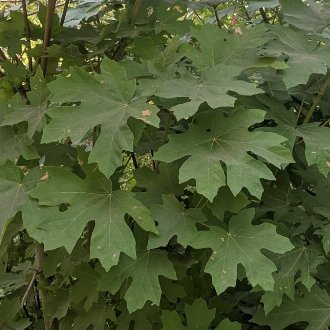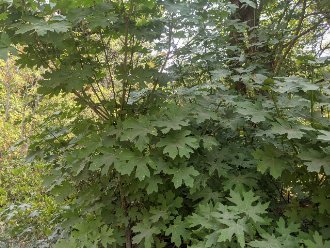Bigleaf Maple (Acer macrophyllum Pursh)
↑Range - Expand
| Legend | Color |
| Native or Expanded or Not Present | |
| Native or Not Present | |
| Native | |
| Expanded or Not Present | |
| Native or Expanded |
This tentative map is based on our own research. It may have limited data on Canada and/or Mexico, and there is some subjectivity in our assignment of plants as introduced vs. expanded. Read more in this blog post.
Although this plant occurs somewhere in each of these regions, it may only occur in a small part of some or all of them.
↑Description & Identification
This species is readily distinguished from other maples by its huge leaves and their distinctive pattern of lobing.
↑Habitat
Found in riparian hardwood forests, early-succesional hardwood growth following fire, and as a minor component of coniferous forests.
This species' range spans a large north-south distance, from a dry Mediterranean climate in the south to a maritime West Coast rainforest climate in the north; as such its habitats are radically different in the different portions of its range. It is mostly limited to a narrow band along the Pacific ocean, and becomes progressively less common farther inland; in the inlandmost portions of its range it is strictly limited to areas with more maritime influence, such as the western-facing slopes of major mountain ranges.
In the southernmost portions of its range, such as southern California, this species is moisture-limited, strictly limited to moist sites, particularly along streams and near springs and other permanent water sources. In Northern California it is most frequent on north- and east-facing slopes, but can be found independently of permanent water sources. From Oregon northward, it still occurs on moist sites begins to also occur on drier sites; in Oregon and Washington it occurs on a variety of drier sites including flat, interior valleys and steep south-facing rocky slopes. In the north of its range, it becomes temperature-limited and is more restricted to warmer sites at low elevations. In coastal British Columbia it is mostly restricted to elevations under 1,000 ft (305 m), except on Vancouver island, where it reaches just above 1,150 ft (350 m), probably due to greater climate moderation from the ocean.
Found on a wide variety of different soil types, including both fine- and coarse-textured soils, deep soils as well as thin soils over bedrock. Does not require particularly nutrient-rich soils, but is highly sensitive to boron toxicity and strictly limited to sites with lower levels of boron. Growth is best on flatter sites with deep soils, but it can be abundant on even steep slopes and sites with thin soils, where it often grows as a shrub.
Tolerant of temporary flooding but killed by flooding that lasts two months or longer; younger trees can be killed by shorter floods.
Found in all successional stages of forests, but prefers earlier stages, where it is more abundant, and becomes uncommon in late successional stages, although it is locally common in certain forest types, and can sometimes be abundant on certain microsites, growing in large clumps for reasons that are not fully understood. One speculation is that these clumps originated when it colonized gaps, but this theory has not been tested or validated. Periodic disturbance from flooding, fire, windthrow, or human disturbances such as logging, often tend to benefit this species. This species is more windfirm than most trees in its range and has a competetive advantage on sites exposed to severe winds.
↑Life Cycle
Seedlings tend to germinate mostly in January-February, with a few stragglers germinating through March and early April. Some later-retained seeds may begin germinating before they fall, but most germinate on the ground. Seeds germinate well both on exposed mineral soils, and soils with an abundance of organic matter. Seedlings survive best when they germinate on sites that stay consistently moist through the first growing season. There is no seed banking; all seeds either germinate their first year or die.
Seedlings grow rapidly, typically much more rapidly than the conifers occurring in the same habitats, with first-year growth of 3.3-6.6ft (1-2m) being common. Seedling growth is best when density is lower, due to competition between seedlings. Seedlings become flood-tolerant quite rapidly and are able to tolerate some brief flooding even during their first year. Trees rapidly develop a shallow, but wide-spreading root system.
Seedlings are frequently killed by herbivory, particularly by rodents and slugs.
Trees begin flowering and producing seed around 10 years of age. Flowers appear as early as March in the warmest parts of its range, to as late as June in the coldest regions; in much of the range, flowers appear before the leaves. Flowers are aromatic and pollinated by insects. Mature trees tend to produce significant volumes of seed every year, but there is some irregular variation of seed crop from tree to tree in each year. Heavily shaded trees have more irregular seed production. Seeds are mostly wind-dispersed and ripen September-October, with most dispersal occurring between October and January, and a few seeds hanging on into March.
If trees are top-killed, they resprout vigorously. However, large, intact trees are poor at compartmentalizing mechanical injury, and often succumb to rot following even minor injury.
Trees tend to live between 50 to 200 years, depending on the site.
↑Uses
Widely used as a landscaping plant, where it is used as a large shade tree. It is valued for its distinctive, unusually large leaves and its ability to thrive on a wide range of sites. As a landscaping plant, they do not respond well to pruning and are best planted on a large site where they will never need to be pruned. Even conservative pruning can lead to injury and rot that can eventually kill a tree.
The sap can be used to produce syrup, much like sugar maple (Acer saccharum), but the syrup tends to be of an inferior quality. Unlike sugar maple which is harvested slightly later in the year, the sap of this species is best harvested in January and February.
Unlike most hardwoods, but like other maples, the sapwood rather than heartwood is more commonly used. This species is particularly preferred for piano frames; it is also used for decorative veneer, boxes, and pallets, with the lowest-quality wood being used as pulp for paper.
The wood tends to be relatively easy to work with, and turns and glues well, but has poor rot resistance and a tendency to burn when machined with high-speed tools. It finishes relatively well but getting even color can be a challenge, and it can form blotches when stained.
Commercially, it is the only maple widely available in the West, and it tends to be classified as soft maple, lumped together with red maple (Acer rubrum) and other species with similar properties as "soft maple". It is usually relatively affordable, but most lumber originates from harvests primarily targeting conifers, and the trees typically originate as resprouts and the wood is of low quality.
This species is also used for firewood; it tends to have a lower heat content than oregon white oak (Quercus garryana) but higher than red alder (Alnus rubra), two other major firewoods in its range.
↑Related Plants
This species is not particularly closely related to most maples native to North America; its closest relatives are all native to other continents; of these the only ones occurring in North America are the field maple (Acer campestre) and Norway maple (Acer platanoides), which is highly invasive in the northeast but only has established on a few sites in the west.
There are a few other maples that overlap with this in range, however, including the box elder (Acer negundo), rocky mountain maple (Acer glabrum), and the vine maple (Acer circinatum), all of which are native.
↑Links & External Resources
• Bigleaf Maple | The Wood Database (About This Site)
• Bigleaf Maple | Fire Effects Information System (FEIS) (About This Site)
• Acer macrophyllum (Bigleaf Maple) | USDA PLANTS Database (About This Site)
• Acer macrophyllum (Bigleaf Maple) | Missouri Botanical Garden Plant Finder (About This Site)
• Bigleaf Maple | Virginia Tech Dendrology Factsheets (About This Site)
• Bigleaf Maple | Silvics of North America (About This Site)
• Acer macrophyllum | Biota of North America Project (BONAP) (About This Site)
• Acer macrophyllum | NatureServe Explorer (About This Site)




